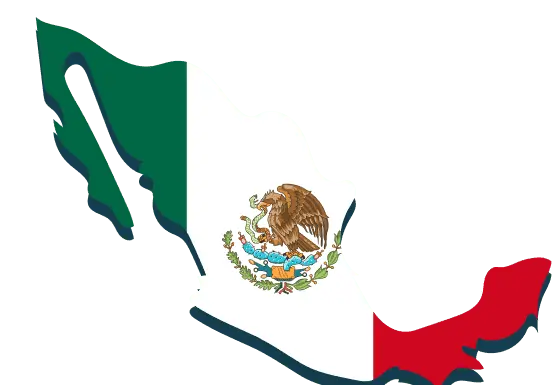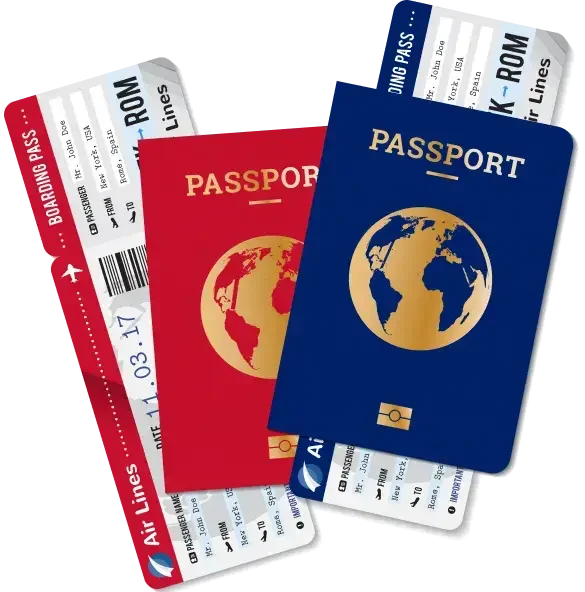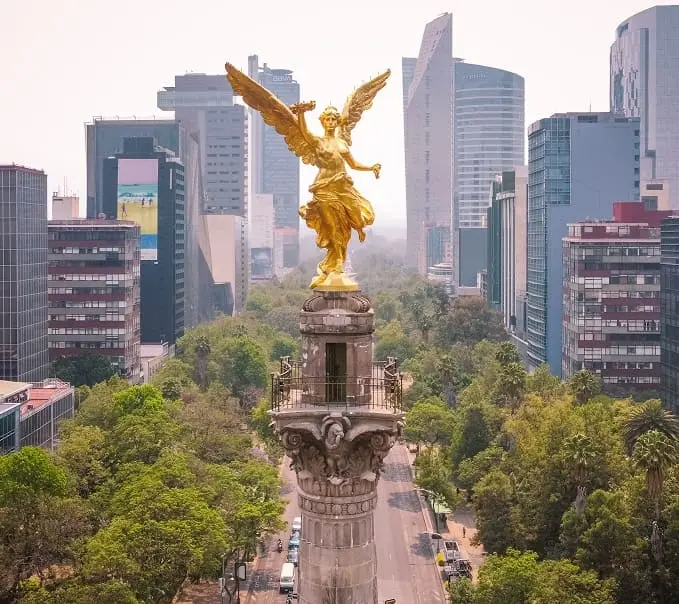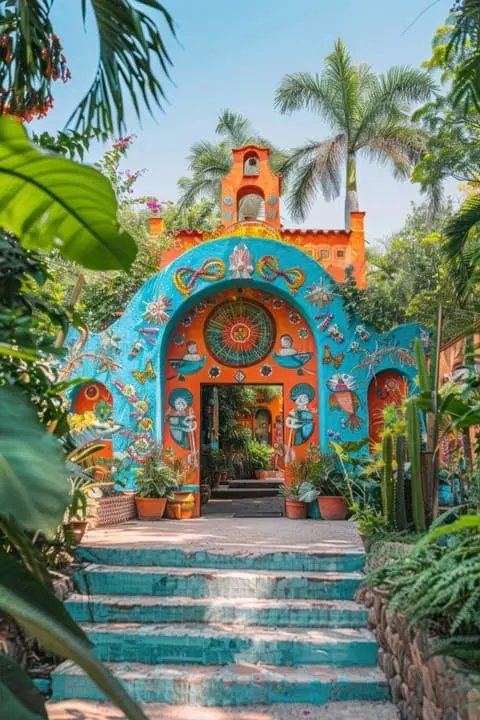Population
GDP (per capital)
Visa-Free Countries
GDP (purchasing power parity)
-
Secure Residency in Mexico in 2025 Through Investment
-
In 2025, Mexico stands out as a top destination for investors seeking residency and a pathway to citizenship. With its rich culture, favorable economy, and flexible immigration policies, the country offers several routes to residency through financial investment.
Unlike traditional paths based on work or family ties, immigration through investment allows individuals to qualify by demonstrating economic means—such as property ownership or capital investment. This article explores the main options available, along with updated requirements for 2025. - Main Industries
- Manufacturing and Industrial Production
- Tourism and Hospitality Services
- Agriculture and Agribusiness
- Automotive and Aerospace Industry
- Oil and Gas Extraction
- Mining and Metal Production
- Food and Beverage Processing

(UTC-6)
1,964,375 km2
Mexican peso (MXN)
Mexico City
Spanish (official), 68 indigenous languages

Overview of the Legal Framework
Mexico’s investor-residency system unfolds in stages:
- Temporary Residency – initially granted for one year (renewable annually up to four years), this status grants the right to live, work, access healthcare, and enroll in schools.
- Permanent Residency – attainable after maintaining temporary residency or, in some investment-based cases, can be applied for directly.
- Citizenship – eligible after maintaining continuous legal residency for approximately five years, allowing dual nationality and full civic participation.
Unlike European-style “golden visas,” Mexico does not offer a direct citizenship-by-investment program. Instead, individuals qualify via residency by investment, whereby demonstrating economic solvency—through assets, real estate, capital investment, or savings—serves as the qualifying pathway.
2025 Update
In 2025, financial thresholds reflect Mexico’s recent inflation and wage adjustments. Specifically:
- Consulates abroad calculate solvency using multiples of the Minimum Daily Wage (MDW), which rose to MXN 279/day at the start of 2025. For instance, temporary residency requires showing approximately 300×MDW in savings or income, translating to around US $4,100 monthly income or US $70,000 in stable savings.
- Immigration offices within Mexico, however, use the Unidad de Medida y Actualización (UMA), which remains lower at MXN 113.14/day. This discrepancy makes in-country processes materially more affordable.
Understanding whether you’re beginning the process at a consulate or within Mexico is crucial, as it affects the required financial benchmarks and overall costs.

Investment Pathways to Residency
Investment Pathways to Residency
Mexico offers several financial routes to legal residency, each designed to attract individuals who can demonstrate economic stability or contribute to the country’s economy. These options differ in structure, cost, and qualifying criteria—but all provide a foundation for securing either temporary or permanent residency.
A. Personal Savings / Financial Solvency
This is one of the most accessible pathways. Applicants can qualify by showing either steady monthly income or a sufficient balance in savings or investment accounts.
- Temporary Residency typically requires proof of savings equivalent to around $60,000–$70,000 USD, or a monthly income of approximately $4,100 USD.
- Permanent Residency, on the other hand, demands significantly more—roughly $220,000–$280,000 USD in assets or higher monthly earnings.
One crucial distinction lies in where you apply:
- Mexican consulates abroad calculate requirements based on the Minimum Daily Wage (MDW), which increased in 2025.
- Immigration offices within Mexico (INM) use the UMA (Unidad de Medida y Actualización), which results in lower financial thresholds. This difference can affect whether applicants qualify—and how much they must show in documentation.
B. Real Estate Ownership
Owning property in Mexico can also pave the way to legal residency, provided the investment meets certain value criteria.
- For Temporary Residency, the property should be worth at least MXN 8.3–11 million, or roughly $437,000 to $558,000 USD, depending on location and market valuation.
- Permanent Residency typically requires a higher investment, generally starting around $450,000 USD and up.
C. Capital Investment in a Mexican Company
Entrepreneurs or business-minded individuals may opt to invest directly in the Mexican economy.
- A minimum investment of MXN 4.1–5.0 million (approximately $218,000 to $293,000 USD) into a legally registered Mexican business may qualify.
- Employing local staff or creating economic value can further strengthen your application and support future requests for permanent residency.
D. Fixed Bank Deposit / Bonds
An alternative option, cited by recent sources in 2025, includes depositing a fixed sum in a Mexican financial institution.
- Holding approximately $120,000 USD in a fixed-term bank deposit or investing $150,000 USD in Mexican government bonds may be accepted, depending on the consulate and supporting documentation.
Investor Visa (“Residency by Investment”)
Investor Visa (“Residency by Investment”)
Mexico’s investor visa provides a flexible route to both temporary and permanent residency for individuals who can demonstrate sufficient financial means. Unlike other visa categories, this option is tailored for those looking to invest in the country’s economy or showcase long-term financial stability.
Key Benefits
Holders of the investor visa enjoy a wide range of rights and services during their stay in Mexico:
- Includes spouse and dependent children under the same application
- Grants the right to work and start or operate a business
- Access to public healthcare and education systems
- Eligible for permanent residency after four years
- Opportunity to apply for citizenship after five years of continuous legal residence
Costs and Fees (2025 Estimates)
| Type of Fee | Estimated Amount (USD) |
|---|---|
| Consular processing fee | $300 – $500 |
| Government fees in Mexico | $2,000 – $5,000 |
| Optional legal/consulting services | Varies by provider |
Application Process
The process begins with an appointment at a Mexican consulate abroad, where applicants submit the required documents and evidence of financial eligibility—such as property deeds, bank statements, or business registration papers.
Processing Times
The timeline for processing the investor visa is relatively efficient:
- Temporary Residency: Typically processed within 2 to 4 months
- Permanent Residency: May take 6 months or longer, depending on documentation and case complexity
The investor visa remains one of the most practical and respected routes to long-term legal residence in Mexico—especially for those who value both personal freedom and financial autonomy. It provides not only a legal foundation to live and work in the country but also a gateway to full integration through permanent status and naturalization.
Tips on Choosing the Right Path & Understanding Consular Nuances
Tips on Choosing the Right Path & Understanding Consular Nuances
Selecting the most suitable investment route depends not only on your financial capacity but also on where and how you apply. In 2025, several subtle—but impactful—factors can affect your eligibility, documentation requirements, and approval timelines. Below are key considerations to keep in mind.
Be Aware of Exchange-Rate Sensitivity
Due to the Mexican peso’s relative weakness in 2025, the U.S. dollar carries more purchasing power. This has slightly lowered the effective dollar thresholds for meeting residency requirements—especially when applying within Mexico, where immigration offices use the UMA (Unidad de Medida y Actualización) to calculate financial criteria.
Tip: Monitor exchange rates closely. Applying when the peso is weaker may help you meet financial thresholds with a smaller dollar-equivalent balance.
Expect Consulate-by-Consulate Differences
While Mexico’s immigration laws are federally standardized, consulates vary in practice. Some may:
- Request evidence of a previous tourist visit to Mexico
- Require additional documentation, such as utility bills or residency ties in your home country
- Interpret financial solvency requirements differently, particularly around income source legitimacy
Financial Documentation: What Counts (and What Doesn’t)
Not all assets are treated equally in proving financial solvency. In 2025:
- IRAs, 401(k)s, pensions, and brokerage accounts are often accepted, provided they show consistent returns or a stable balance
- Cryptocurrencies are generally not accepted due to volatility and valuation challenges
- Funds must be held in your name and readily accessible—joint accounts or business assets may be subject to extra scrutiny
By understanding these nuances in advance, applicants can avoid common pitfalls and streamline the process. Whether applying abroad or in-country, doing your homework on consular practices and preparing diversified financial documentation will significantly improve your chances of approval.
Step-by-Step Guide to Immigrating Through Investment
Navigating Mexico’s residency-by-investment process can feel complex, but breaking it down into clear stages makes it manageable. Here’s a straightforward roadmap to help you on your journey:
Select Your Investment Route
Decide which path suits your financial profile and lifestyle goals—whether that’s demonstrating personal savings, purchasing real estate, investing in a Mexican business, or placing funds in a fixed bank deposit.
Gather Required Documentation
Collect and organize all necessary paperwork, including bank statements, property titles, business plans, and proof of financial solvency. Ensuring these documents are accurate and up-to-date will smooth your application.
Schedule a Consulate Appointment
Book your visa interview at the nearest Mexican consulate. Submit your application for a Temporary Resident or Investor visa, depending on your chosen investment method and eligibility.
Travel to Mexico and Register with INM
Once your visa is approved, enter Mexico within the validity period and visit the National Institute of Migration (INM) to obtain your Temporary Resident card.
Apply for Permanent Residency
After maintaining Temporary Residency for four years—or immediately in some investment cases—you may apply to upgrade your status to Permanent Residency.
Pursue Mexican Citizenship
Following five years of continuous Permanent Residency, you become eligible to apply for naturalization, granting full citizenship rights, including dual nationality.
This sequence offers a clear, actionable framework tailored to 2025 regulations, helping investors confidently transition from initial application to citizenship in Mexico.

Timeline and Post-Arrival Considerations
Understanding the typical timeline and what to expect after arriving in Mexico is crucial for a smooth transition.
- Temporary Visa Processing: Applications usually take between 2 to 4 months to be approved at the consulate. Once in Mexico, the Temporary Resident card is generally issued within a few weeks after registering with the National Institute of Migration (INM).
- Permanent Residency: Applying for permanent status often requires an additional 6 months or more for review and approval, depending on the completeness of your documentation and processing times.
- Citizenship Eligibility: After maintaining 4 to 5 years of continuous legal residency, applicants may become eligible to pursue Mexican citizenship, which opens the door to full civic rights, including dual nationality.
- Financial Planning: Keep in mind that Mexico adjusts its residency financial thresholds annually, often linked to inflation and wage changes. To avoid surprises, it’s wise to budget with a 15–20% buffer above the stated minimum requirements.
Having realistic expectations about timing and costs will help you prepare thoroughly and enjoy a hassle-free settlement in Mexico.
Conclusion
Mexico offers multiple investment routes to residency, with financial requirements that adjust regularly to reflect inflation and wage changes. Slight variations exist between consulates, so staying informed is crucial. Consulting official sources or immigration experts will help ensure a smooth application process and a successful transition to life in Mexico.
FAQ about How to Secure Residency in Mexico in 2025 Through Strategic Investment
What are the main investment options to qualify for Mexican residency?
You can qualify by demonstrating personal savings or income, purchasing real estate above a set value, investing in a Mexican business, or making fixed bank deposits or bond investments.
How long does it take to obtain a Temporary Resident Visa through investment?
Processing generally takes between 2 to 4 months at the consulate, followed by a few weeks to receive the resident card after arrival in Mexico.
Can family members be included in the investor visa application?
Yes, spouses and dependent children can be included under the same investor visa, allowing the entire family to live and work in Mexico.
When can I apply for permanent residency and citizenship?
Permanent residency is usually available after four years of temporary residency (or sooner for certain investors), and citizenship can be sought after five years of continuous permanent residency.
Looking for expert visa support?
PROGRAM MATCH
Compare the different programs in a nutshell and discover their features
PROGRAM COST
Check the cost estimates for each offered program
PROGRAM MAP
Explore the power of global mobility for every passport in the world
